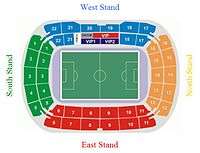Lokomotiv Stadium (Moscow)
| Lokomotiv Central Stadium | |
 | |
| Former names | Stalinets |
|---|---|
| Location | Moscow, Russia |
| Coordinates | 55°48′13″N 37°44′28″E / 55.80361°N 37.74111°ECoordinates: 55°48′13″N 37°44′28″E / 55.80361°N 37.74111°E |
| Owner | Russian Railways |
| Operator | Lokomotiv Moscow |
| Capacity | 28,800 |
| Surface | Grass |
| Construction | |
| Broke ground | 2000 |
| Opened | 5 July 2002[2] |
| Construction cost | $150-170 Million[3][4] |
| Architect | Dmitry Bush |
| Tenants | |
|
FC Lokomotiv Moscow Russia Rugby League | |

The Lokomotiv Central Stadium (Russian: «Локомотив») is a football stadium in Moscow, Russia. It is the home stadium of Lokomotiv Moscow and was the home ground of the Russian National Team for the 2010 FIFA World Cup qualification matches. The stadium was reconstructed in 2002 and holds 30,075 people, all seated. This reconstruction of the stadium was funded by the Russian Transportation Ministry at cost of $150-170 million.
History
Stalinets
In 1935, at the site where the Lokomotiv Stadium is resided today, an electric workers union decided to build a stadium which was named "Stalinets" or "Stalinist Stadium". At that time Stalinets held about 30,000 spectators.[5]
Development of Lokomotiv Stadium
After holding several key matches and establishing itself as a symbol of football in Moscow, Stalinets was demolished to make way for a more modern stadium. Thus, Lokomotiv stadium was built. It was opened on 17 August 1966 with a capacity of 30,000 people. However, in the mid-90's the capacity of the stadium was reduced by 6,000 to 24,000, as the wooden benches were replaced by plastic seats.
The inaugural match played at the Lokomotiv stadium was between Lokomotiv Moscow and Dynamo Kiev. As years rolled on, Lokomotiv held several important matches such as Russian National team home matches, Lokomotiv matches and others. The stadium also played host to a European Cup Qualifier between FC Spartak Moscow and Swiss club FC Sion. The match finished 2-2; however, the Swiss club then forced UEFA to measure the posts for compliance with international standards. Indeed, the size of the posts were shown to infringe international standards. Eventually, UEFA ordered a replay, which Spartak won 5-1.
Re-construction
Despite the fact that Lokomotiv Stadium was still of good quality, the Lokomotiv Moscow board felt that a new stadium would be the best option. The construction was backed by the Russian Transport Ministry. The new stadium held its first match on July 5, 2002 when Lokomotiv Moscow welcomed Uralan Elista. The home team won 1-0 and the first official goal scored at the new stadium was an own goal by Dmitry Semochko.
Description

Lokomotiv was designed solely for football matches and thus has no running tracks. The pitch, which is 104mx68m, is surrounded by two-tiered four all-seater stands, the North Stand, the South Stand, the East Stand and the West Stand. The South Stand is home to the Lokomotiv Moscow ultras. On the other hand, travelling fans generally reside in the North Stand. All the stands are covered by a roof, by thus protecting the fans from the Russian harsh weather elements. The total areas of the glass roof is 20,000 square metres. A unique characteristic of the stadium are the VIP-Boxes found in between the upper and lower tiers of all the stands, with one of them being even a restaurant. Furthermore, the stadium comprises other three VIP-sectors, one of them being of soft-seats. Altogether they total to 974 VIP-seats. Furthermore, there are 156 seats available for the press. Thus in all the stadium holds 30,000 people. Moreover, beneath the stands one can find a fitness centre, a bowling club and also the offices of both the club and the fan club.
Moreover, beside the stadium one can find the Minor Sports Arena Lokomotiv.
Concerts
Depeche Mode performed at the stadium on June 22, 2013 during their Delta Machine Tour, in front of a sold out crowd of 27,886 people.
See also
References
- ↑ http://www.fclm.ru/en/club/stadium
- ↑ http://www.worldofstadiums.com/europe/russia/lokomotiv-central-stadium-moscow/
- ↑ https://www.vedomosti.ru/newspaper/articles/2004/10/08/novyj-stadion-v-obmen-na-jelitnoe-zhile
- ↑ http://www.odnako.org/almanac/material/stadion-zhelaniy/
- ↑ http://www.oldmos.ru/photo/view/2891
External links
| Wikimedia Commons has media related to Lokomotiv Stadium (Moscow). |
- Lokomotiv Stadium
- (Russian) Article about the stadium
| Preceded by Rajamangala National Stadium Bangkok |
FIFA U-20 Women's World Championship Final Venue 2006 |
Succeeded by Estadio Bicentenario Municipal La Florida |